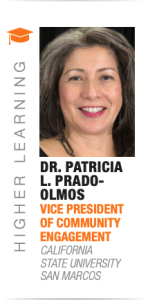Symposium spotlights social mobility
Almost a decade ago, at another university on another coast, Ellen Neufeldt set out to organize a symposium on social mobility. As she called around to invite participants as an administrator at Old Dominion University in Virginia, she received the same answer again and again: “I will come, but first you must tell me what social mobility is.” Neufeldt related that story in February under a very different set of circumstances. She’s now in her sixth year as president of Cal State San Marcos. Social mobility has increasingly gained prominence in the world of higher education.
And, most significantly, Neufeldt was speaking to an audience of more than 400 people packed into the University Student Union ballroom for the now-annual National Social Mobility Symposium. A cross-section of education, government and other leaders from across the country congregated over a day-and-a-half to delve into the once-foreign concept and the many ways that social mobility is interconnected with the vital work of educating students.
“The national and higher education conversation has changed in many ways,” Neufeldt said in remarks kicking off the symposium. “Right here at CSUSM and in the CSU in general, social mobility has been part of the core mission of who we are.
In fact, through CSUSM’s strategic planning, we established our vision to be a national leader in social mobility. “While social mobility includes upward economic mobility, it also encompasses broader access to opportunities and resources, education, and overall quality of life.”
In a fortuitous stroke of timing, the symposium began on the same day that the College Futures Foundation – an Oakland-based nonprofit – released its inaugural California Mobility Index. The CMI ranks four-year institutions in the state based not on how exclusive they are, but rather on the rate of low- and medium-income students they enroll and the return on investment they provide. California State University campuses account for 13 of the top 15 spots (including CSUSM) in the CMI, the debut of which drew coverage from such media outlets as the Los Angeles Times and EdSource. CSU Chancellor Mildred Garcia was one of four keynote speakers at the symposium, calling it one of the system’s “signature events.”
“At the CSU and at our peer institutions represented here today, social mobility is our greatest strength, our immense source of pride, and it’s our reason for being,”
Garcia said.
Joining Garcia as keynote speakers at the symposium were Nate Hilger, an economist and data scientist and author of the book “The Parent Trap: How to Stop Overloading Parents and Fix Our Inequality Crisis”; Charles Welch, president of the American Association of State Colleges and Universities; and Alejandra Campoverdi, founder of the First Gen Fund and a former White House aide to President Barack Obama.
Also, two current or former elected officials spoke to the assembled crowd: Toni Atkins, the former leader of the California State Senate; and Scott Peters, the U.S. representative of the congressional district (50th) that includes San Marcos. Atkins talked about the tie between her own story of social mobility as a first-generation college graduate who grew up poor in Appalachia and her political work in the state as a fierce advocate of education, affordable housing and LGBTQ rights. “Social mobility allowed me, the daughter of a seamstress from Appalachia, to become the first woman to be president pro tempore of the California State Senate,” Atkins said. “It allowed me to live a life far beyond my dreams. I want to make sure current and future students get a chance to live that life as well.”
We are currently experiencing a power outage.
We expect the power to be restored at 3PM PDT.
We expect the power to be restored at 3PM PDT.
